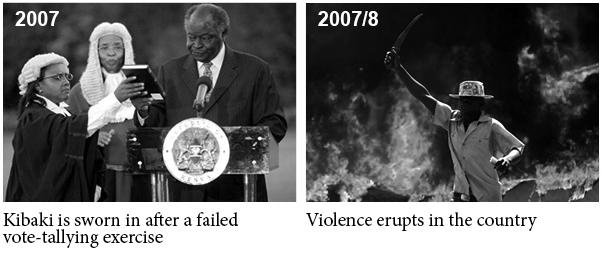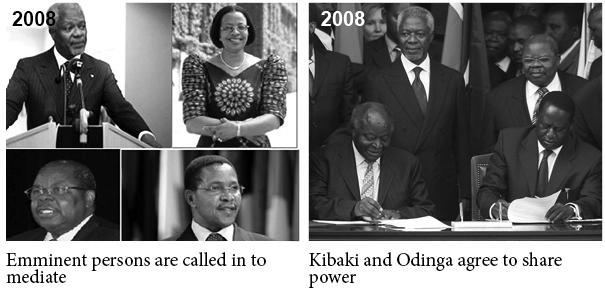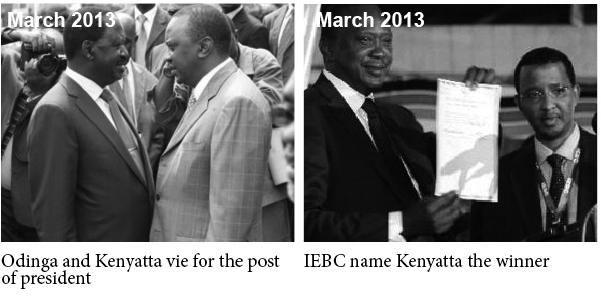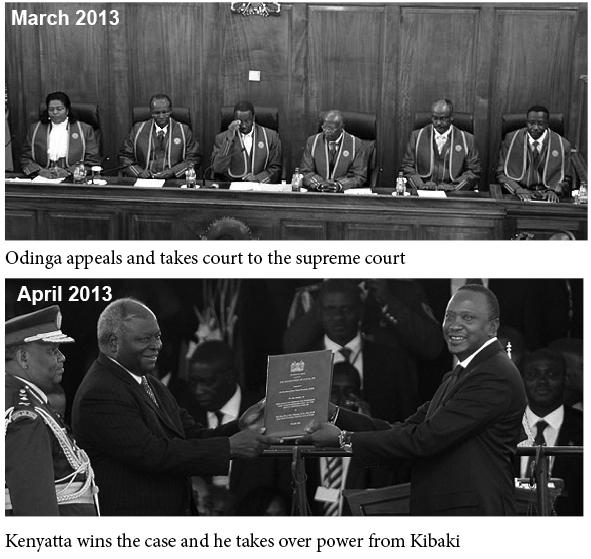In December 2007, Kenya, a country in East Africa held its national elections. At the time, the two main contenders for the presidential position were incumbent Emilio Mwai Kibaki and Raila Odinga.
The final results of the exercise were never released after the transparency of the tallying process was compromised. However, Kibaki was named the winner and sworn in at night, something that aggrieved the supporters of Odinga, who took to the streets in protest (Maina, n.d.).
In a few days, the protest had blown up to be a national war, with the supporters of the two leaders maiming and killing each other (Kenya elections on the brink, n.d.).
The tribal disagreements that had for a very long time been simmering underneath the surface blew up leading to the displacement of individuals who did not belong to the “right” tribe.
The fighting went on for three months, with international unions urging the two leaders, Odinga and Kibaki, to find an amicable solution before the situation escalated to uncontrollable levels.
The African Union set up a committee of eminent of persons, which was tasked with the responsibility of mediating the negotiations between the two leaders (The eminent Kenyan personalities, n.d.).
After weeks of discussion, an agreement was finally reached. Kibaki and Raila agreed to share power on a 50-50 basis, with the former retaining the post of president and the latter being assigned the position of Prime Minister, a position that was set up to help avert the situation (Kibaki and Odinga sign accord, n.d.).
Five years later, Kenya was due for another election. This time around, the main contestants for the presidency were Odinga and Uhuru Kenyatta (Raila Odinga will beat Kenyatta, n.d.).
The two groups went for campaigns around the country, but there was still the fear that the traumatic incidents of 2007/8 might recur.
Odinga and Kenyatta pledged to uphold peace and even held a joint prayer meeting, during which they shook hands and pledged to urge their supporters not to resort to violence.
The elections were held on March 4th, 2013 and according to released statistics, the attendance was the best recorded in the country’s history.
There were long queues at the different polling centers, with some individuals reporting having to stand in line for over eight hours to cast their ballot.
During this time, all the leaders kept insisting on the maintenance of peace, and by the close of the elections day, very few disagreements were reported, all of which were well handled.
Because the violence in 2007/8 was seen to arise as a result of a lack of transparency in the vote-counting process, careful attention was given the tallying exercise in 2013.
As a security measure, the Independent Elections and Boundaries Commission (IEBC), which was assigned the role of conducting the elections, had installed electronic result transmission systems, which were said to provide the total-tally in real-time.
The first few hours results from the different counties were sent to the main tallying center, located in the country’s capital city, Nairobi. The installed systems added the results as they came into the totals, which were then transmitted to the rest of the country, through live television broadcasts.
The country had been made to believe that the technology in use would help complete the tallying exercise in less than one day. However, by the end of the second day, less than 30% of the results had been tallied.
Later, Isaack Hassan, the Chairman of the IEBC came out to reveal that the system had crashed and could no longer be used for the counting exercise. Because of this failure, the tallying process was taken back to the manual system, used in 2007.
This change from digital to manual tallying made the tension-levels in the country rise a notch higher because IEBC could not immediately guarantee that the results being transported from all the counties could get to Nairobi without being tampered with.
The media kept broadcasting the appeals for peace from different leaders around the world, including America’s Barrack Obama.
The manual tallying process took five days, after which Kenyatta was declared the winner, having beaten Odinga by over one million votes (IEBC declares Uhuru Kenyatta Kenya’s fourth president, n.d.).
Odinga, on his part, was not satisfied with the final tally, saying that he had a suspicion that the count could have been compromised after the unexplainable failure of the electronic transmission system.
However, unlike in 2007, when he called out his supporters to protest the outcome in the streets, this time he decided to appeal to the court. Odinga accused the IEBC of not having discharged their duties as per the given mandate.
He also accused Kenyatta’s Jubilee coalition of having played a hand in the manipulation of results from different regions around the country in their favor.
The court battle was branded the biggest judicial challenge the country had ever experienced and to make the ruling, the judicial arm of the government assembled a bench of six supreme-court judges, led by Chief Justice Willy Mutunga (Kenya supreme court judges, n.d.).
Odinga and Kenyatta each contracted the most renowned lawyers from the country to help them argue their case, with the Kenyatta, reported having hired 30 lawyers to help counter Odinga’s force. The IEBC also had its team of lawyers, also comprising some of the best attorneys in the region.
The listening phase of the appeal took three days, with all the sessions being broadcast live on all the eight television stations in the country.
After Odinga had provided his appeal and Kenyatta countering it by handing in evidence against the allegations, it came down to the six-man bench to rule on the case.
The ruling was provided on 30th March, with Chief Justice Mutunga declaring that they had come to a unanimous agreement that Kenyatta had won the elections fairly. This saw the appeal get thrown out of court allowing the plans to swear in Kenyatta to go on.
Kenyatta and his running-mate William Ruto were sworn in a 9th April, taking over from Kibaki, who had completed the two terms allowed by the constitutions (Uhuru takes over power, n.d.).
From the entire process, no inter-tribal fighting was reported, and the joke around Kenya was that the international media were disappointed because they did not get the violence they flew in to report about.
For the good display, Kenya received acclaim from international quarters, with the heads of different countries from within and outside Africa sending in congratulatory messages.
Odinga and Kenyatta have since the inauguration of the latter as the president put aside their differences and are working to help reconcile the country.




Reference List
IEBC declares Uhuru Kenyatta Kenya’s fourth president [Image] (n.d.). Web.
Kenya elections on the brink [Image] (n.d.). Web.
Kenya supreme court judges. [Image] (n.d.). Web.
Kibaki and Odinga sign accord. [Image] (n.d.). Web.
Maina, S. [Image] (n.d.). Kibaki sworn in. Web.
Raila Odinga will beat Kenyatta [Image] (n.d.). Web.
The Kenyan eminent personalities [Image] (n.d.). Web.
Uhuru takes over power. [Image] (n.d.). Web.